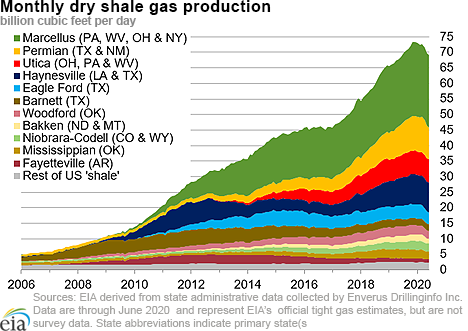In the News:
U.S. sets record for natural gas power burn
In the United States, natural gas consumed by electric power plants (power burn) set a record high of 46.7 billion cubic feet (Bcf) on Monday, July 27, according to S&P Global Platts estimates. On the same day, natural gas-fired capacity reached an all-time high dispatch level, reaching 315,989 megawatts (MW) in the late afternoon, according to EIA’s Hourly Electric Grid Monitor. Since July 1, 2020, U.S. power burn has exceeded the previous record of 45.4 Bcf/d―set on August 6, 2019―on six days: July 9, July 20–21, and July 27–29. The following are factors that contributed to this increased natural gas use:
Warmer-than-normal temperatures: High electricity demand for space cooling was the major contributor to the record power burn. However, unlike the day of the power burn record set last year, no particular heat wave was associated with this record. Maximum temperatures were higher than normal in the Northeast and Northwest, and minimum temperatures were elevated in much of the country, leading to additional off-peak cooling demands.
Relatively low natural gas prices: Natural gas at the benchmark Henry Hub in Louisiana averaged $1.73 per million British thermal units (MMBtu) for natural gas delivered on July 27, according to Natural Gas Intelligence. From June 1 to July 30, Henry Hub prices averaged $1.64/MMBtu, 30% lower than the prices during the same period in 2019. Adjusted for inflation, this average price is the lowest average price for this period since at least 1993 (the limit of Natural Gas Intelligence’s records).
Structural change in the electric power industry: Since January 2019, 8.4 gigawatts (GW) of natural gas-fired net summer capacity (13.8 GW added; 5.4 GW retired) has been added in the United States, as opposed to 0.2 GW of net summer capacity additions (21.5 GW added; 21.3 GW retired) of other power sources, according to Form EIA-860M data. Most of the new natural gas-fired capacity were combined-cycle power plants using the latest in high efficiency natural gas turbine technology, and these plants are capable of supplying baseload power. In contrast, the retired natural gas-fired plants were mostly steam or combustion turbines, which primarily are used to supply peak power loads.
Most of the non-natural gas-fired capacity that was added since the start of 2019 was intermittent renewables, such as wind or solar. In contrast, most of the retired non-natural gas-fired plants were coal or nuclear-powered, which tended to provide baseload power. As a result of these changes, natural gas-fired generators currently comprise about 44% of the total net summer capacity of all electric power generation in the United States.
Relatively high levels of nuclear power plant outages: According to EIA’s daily nuclear capacity outage report, 5.6 GW of nuclear power plant capacity was not operating on July 27. This amount is 250% higher than the 1.6 GW of nuclear outages on July 27, 2019, and 37% higher than the date’s previous five-year (2015–19) maximum of 4.1 GW. This July, U.S. nuclear outages have averaged 3.6 GW, 113% higher than outages during the same period in 2019.
Overview:
(For the week ending Wednesday, August 5, 2020)
- Natural gas spot prices were mixed at most locations this report week (Wednesday, July 29 to Wednesday, August 5). The Henry Hub spot price rose from $1.75 per million British thermal units (MMBtu) last Wednesday to $2.18/MMBtu yesterday.
- At the New York Mercantile Exchange (Nymex), the August 2020 contract expired last Wednesday at $1.854/MMBtu. The September 2020 contract price increased to $2.191/MMBtu, up 26¢/MMBtu from last Wednesday to yesterday. The price of the 12-month strip averaging September 2020 through August 2021 futures contracts climbed 9¢/MMBtu to $2.714/MMBtu.
- The net injections to working gas totaled 33 billion cubic feet (Bcf) for the week ending July 31. Working natural gas stocks totaled 3,274 Bcf, which is 22% more than the year-ago level and 15% more than the five-year (2015–19) average for this week.
- The natural gas plant liquids composite price at Mont Belvieu, Texas, rose by 11¢/MMBtu, averaging $5.00/MMBtu for the week ending August 5. The price of butane fell by 5%. The prices of ethane, natural gasoline, and isobutane rose by 1%, 8%, and 15%, respectively. The price of propane remained flat week over week.
- According to Baker Hughes, for the week ending Tuesday, July 28, the natural gas rig count increased by 1 to 69, the first increase following six weeks of consecutive declines. The number of oil-directed rigs fell by 1 to 180. The total rig count stayed at 251.
Prices/Supply/Demand:
Prices are mixed across the Lower 48 states as Hurricane Isaias moves across the Eastern Seaboard. This report week (Wednesday, July 29 to Wednesday, August 5), the Henry Hub spot price rose 43¢ from a low of $1.75/MMBtu last Wednesday to a high of $2.18/MMBtu yesterday, its highest price since February following 115 consecutive days of trading at less than $2.00/MMBtu. Temperatures were mixed, with cooler-than-normal temperatures in the Midwest and warmer-than-normal temperatures on the East and West Coasts. At the Chicago Citygate, the price increased 16¢ from $1.79/MMBtu last Wednesday to a high of $1.95/MMBtu yesterday.
Hurricane Isaias leaves millions of East Coast customers without power. Hurricane Isaias made landfall near Ocean Isle, North Carolina, late Monday night and moved its way up the Eastern Seaboard on Tuesday. A peak of approximately 3.6 million customers lost power on Tuesday evening from the Carolinas to Maine as Isaias moved through the region. As of last night, 2.5 million customers were still without power. Customers can continue to monitor disruptions using EIA’s Energy Disruptions map.
Northeast prices decrease. At the Algonquin Citygate, which serves Boston-area consumers, the price went down 17¢ from $1.74/MMBtu last Wednesday to $1.57/MMBtu yesterday. At the Transcontinental Pipeline Zone 6 trading point for New York City, the price decreased 23¢ from a high of $1.80/MMBtu last Wednesday to $1.57/MMBtu yesterday.
The Tennessee Zone 4 Marcellus spot price increased 10¢ from $1.20/MMBtu last Wednesday to $1.30/MMBtu yesterday. The price at Dominion South in southwest Pennsylvania rose 12¢ from $1.30/MMBtu last Wednesday to $1.42/MMBtu yesterday.
California prices are mixed. The price at PG&E Citygate in Northern California rose 14¢, up from $2.59/MMBtu last Wednesday to a high of $2.73/MMBtu yesterday. The price at SoCal Citygate in Southern California decreased 40¢ from a high of $2.60/MMBtu last Wednesday to $2.20/MMBtu yesterday as below-average temperatures Tuesday and Wednesday limited power demand. Yesterday, the Transwestern Pipeline Company issued a force majeure at a compressor station 45 miles west of Albuquerque, New Mexico, reducing westbound flows by 0.1 Bcf/d and putting upwards pressure on Southern California prices.
Permian Basin prices fall, widening the basis to the Henry Hub. The price at the Waha Hub in West Texas, which is located near Permian Basin production activities, averaged a high of $1.32/MMBtu last Wednesday, 43¢/MMBtu lower than the Henry Hub price. Yesterday, the price at the Waha Hub averaged $1.13/MMBtu, $1.05/MMBtu lower than the Henry Hub price. The price at the Waha Hub briefly fell to as low as 26¢/MMBtu on Friday after the El Paso Natural Gas company issued a force majeure associated with the Cornudas Compressor Station Unit 1B, restricting capacity by about 0.5 Bcf/d according to S&P Platts.
Supply falls. According to data from IHS Markit, the average total supply of natural gas fell by 0.2% compared with the previous report week. This decline was driven by a decrease in dry natural gas production of 0.7% compared with the previous report week. Average net imports from Canada increased by 10.0% from last week.
Demand falls as natural gas demand is limited amid hurricane-related power outages. Total U.S. consumption of natural gas fell by 6.2% compared with the previous report week, according to data from IHS Markit. Natural gas consumed for power generation declined by 9.3% week over week. In the residential and commercial sectors, consumption declined by 8.8%. Industrial sector consumption increased by 1.8% week over week. Natural gas exports to Mexico increased 1.1%. Feedgas to liquefied natural gas (LNG) terminals averaged 0.6 Bcf/d, or 19%, higher than last week.
U.S. LNG exports decrease week over week. Five liquefied natural gas (LNG) vessels (three from Sabine Pass, and one each from Cameron and Corpus Christi) with a combined LNG-carrying capacity of 18 Bcf departed the United States between July 30 and August 5, 2020, according to shipping data provided by Marine Traffic.
Storage:
The net injections into storage totaled 33 Bcf for the week ending July 31, compared with the five-year (2015–19) average net injections of 33 Bcf and last year's net injections of 58 Bcf during the same week. Working natural gas stocks totaled 3,274 Bcf, which is 429 Bcf more than the five-year average and 601 Bcf more than last year at this time.
According to The Desk survey of natural gas analysts, estimates of the weekly net change to working natural gas stocks ranged from net injections of 23 Bcf to 35 Bcf, with a median estimate of 30 Bcf.
The average rate of injections into storage is 10% higher than the five-year average so far in the refill season (April through October). If the rate of injections into storage matched the five-year average of 9.5 Bcf/d for the remainder of the refill season, the total inventory would be 4,152 Bcf on October 31, which is 429 Bcf higher than the five-year average of 3,723 Bcf for that time of year.
More storage data and analysis can be found on the Natural Gas Storage Dashboard and the Weekly Natural Gas Storage Report.
See also:
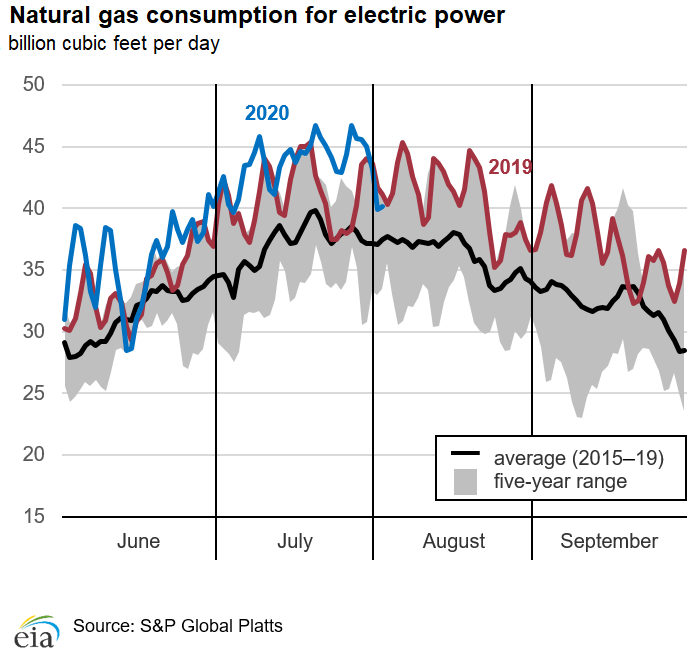
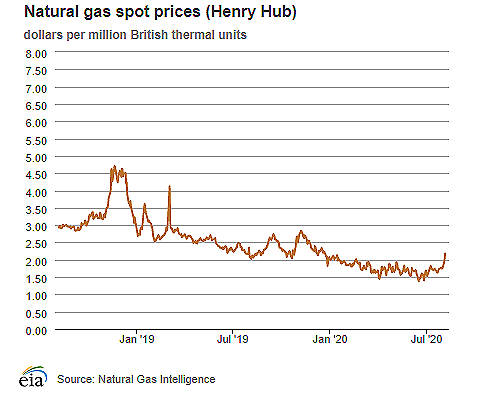
| Spot Prices ($/MMBtu) | Thu, 30-Jul |
Fri, 31-Jul |
Mon, 03-Aug |
Tue, 04-Aug |
Wed, 05-Aug |
|---|---|---|---|---|---|
| Henry Hub |
1.75 |
1.75 |
1.92 |
2.02 |
2.18 |
| New York |
1.52 |
1.51 |
1.64 |
1.79 |
1.57 |
| Chicago |
1.75 |
1.66 |
1.80 |
1.92 |
1.95 |
| Cal. Comp. Avg.* |
2.21 |
2.05 |
2.12 |
2.19 |
2.20 |
| Futures ($/MMBtu) | |||||
| September contract | 1.829 |
1.799 |
2.101 |
2.193 |
2.191 |
| October contract |
1.991 |
1.957 |
2.239 |
2.334 |
2.331 |
| *Avg. of NGI's reported prices for: Malin, PG&E Citygate, and Southern California Border Avg. | |||||
| Source: NGI's Daily Gas Price Index | |||||
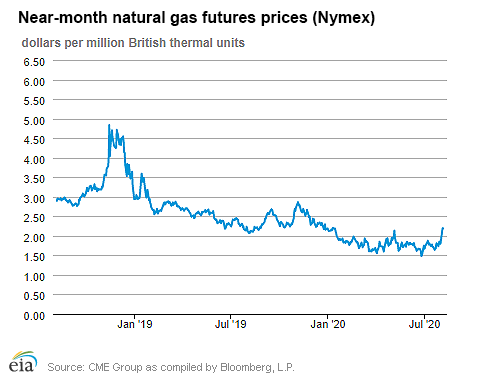
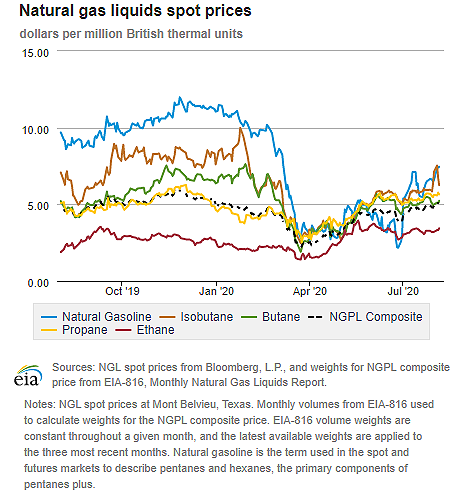
| U.S. natural gas supply - Gas Week: (7/30/20 - 8/5/20) | |||
|---|---|---|---|
Average daily values (Bcf/d): |
|||
this week |
last week |
last year |
|
| Marketed production | 100.0 |
101.0 |
104.5 |
| Dry production | 88.6 |
89.2 |
92.0 |
| Net Canada imports | 4.8 |
4.4 |
4.7 |
| LNG pipeline deliveries | 0.1 |
0.2 |
0.1 |
| Total supply | 93.5 |
93.7 |
96.7 |
|
Source: IHS Markit | |||
| U.S. natural gas consumption - Gas Week: (7/30/20 - 8/5/20) | |||
|---|---|---|---|
Average daily values (Bcf/d): |
|||
this week |
last week |
last year |
|
| U.S. consumption | 69.0 |
73.6 |
71.8 |
| Power | 40.1 |
44.3 |
42.2 |
| Industrial | 20.7 |
20.3 |
21.1 |
| Residential/commercial | 8.2 |
9.0 |
8.5 |
| Mexico exports | 5.7 |
5.6 |
5.2 |
| Pipeline fuel use/losses | 6.8 |
7.0 |
6.5 |
| LNG pipeline receipts | 3.8 |
3.2 |
5.2 |
| Total demand | 85.3 |
89.5 |
88.8 |
|
Source: IHS Markit | |||
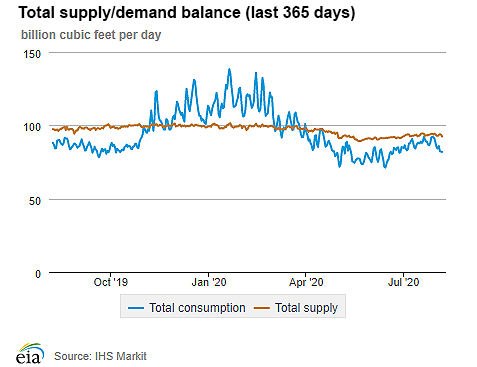
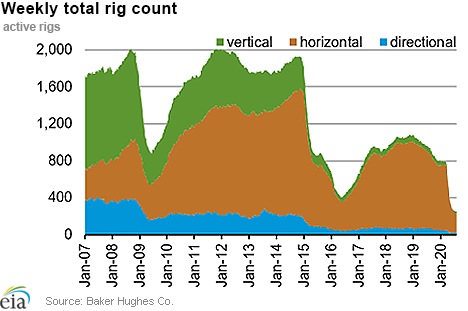
| Rigs | |||
|---|---|---|---|
Tue, July 28, 2020 |
Change from |
||
last week |
last year |
||
| Oil rigs | 180 |
-0.6% |
-76.6% |
| Natural gas rigs | 69 |
1.5% |
-59.6% |
| Note: Excludes any miscellaneous rigs | |||
| Rig numbers by type | |||
|---|---|---|---|
Tue, July 28, 2020 |
Change from |
||
last week |
last year |
||
| Vertical | 13 |
-7.1% |
-76.8% |
| Horizontal | 216 |
0.5% |
-73.6% |
| Directional | 22 |
0.0% |
-67.2% |
| Source: Baker Hughes Co. | |||
| Working gas in underground storage | ||||
|---|---|---|---|---|
Stocks billion cubic feet (Bcf) |
||||
| Region | 2020-07-31 |
2020-07-24 |
change |
|
| East | 718 |
706 |
12 |
|
| Midwest | 830 |
815 |
15 |
|
| Mountain | 202 |
196 |
6 |
|
| Pacific | 311 |
313 |
-2 |
|
| South Central | 1,214 |
1,211 |
3 |
|
| Total | 3,274 |
3,241 |
33 |
|
|
Source: Form EIA-912, Weekly Underground Natural Gas Storage Report | ||||
| Working gas in underground storage | |||||
|---|---|---|---|---|---|
Historical comparisons |
|||||
Year ago (7/31/19) |
5-year average (2015-2019) |
||||
| Region | Stocks (Bcf) |
% change |
Stocks (Bcf) |
% change |
|
| East | 608 |
18.1 |
645 |
11.3 |
|
| Midwest | 694 |
19.6 |
707 |
17.4 |
|
| Mountain | 160 |
26.3 |
179 |
12.8 |
|
| Pacific | 271 |
14.8 |
293 |
6.1 |
|
| South Central | 939 |
29.3 |
1,021 |
18.9 |
|
| Total | 2,673 |
22.5 |
2,845 |
15.1 |
|
| Source: Form EIA-912, Weekly Underground Natural Gas Storage Report | |||||
| Temperature – heating & cooling degree days (week ending Jul 30) | ||||||||
|---|---|---|---|---|---|---|---|---|
HDD deviation from: |
CDD deviation from: |
|||||||
| Region | HDD Current |
normal |
last year |
CDD Current |
normal |
last year |
||
| New England | 0 |
-2 |
0 |
88 |
43 |
20 |
||
| Middle Atlantic | 0 |
-3 |
0 |
95 |
36 |
17 |
||
| E N Central | 0 |
-4 |
-1 |
75 |
17 |
14 |
||
| W N Central | 0 |
-3 |
-2 |
82 |
10 |
21 |
||
| South Atlantic | 0 |
0 |
0 |
115 |
18 |
22 |
||
| E S Central | 0 |
0 |
0 |
105 |
10 |
26 |
||
| W S Central | 0 |
0 |
0 |
122 |
-4 |
7 |
||
| Mountain | 0 |
-3 |
0 |
84 |
5 |
-12 |
||
| Pacific | 1 |
-2 |
1 |
54 |
7 |
-17 |
||
| United States | 0 |
-2 |
0 |
91 |
16 |
10 |
||
|
Note: HDD = heating degree day; CDD = cooling degree day Source: National Oceanic and Atmospheric Administration | ||||||||
Average temperature (°F)
7-day mean ending Jul 30, 2020
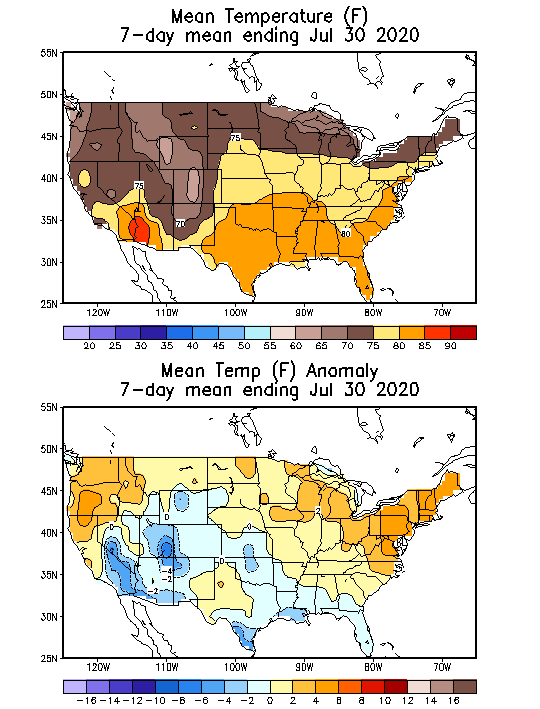
Source: National Oceanic and Atmospheric Administration
Deviation between average and normal (°F)
7-day mean ending Jul 30, 2020

Source: National Oceanic and Atmospheric Administration

